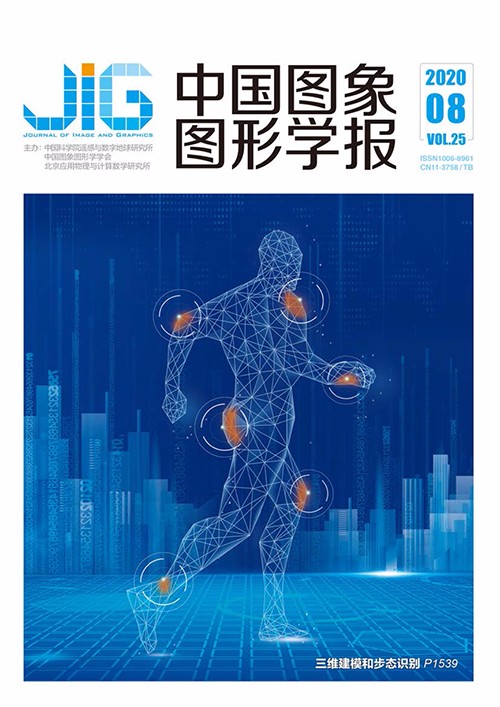
突变策略下多通路Metropolis光照传播
摘 要
目的 针对多通路Metropolis光照传播(multiplexed Metropolis light transport,MMLT)算法在亮度不均匀区域接受概率低、采样数量与光照分布不对称以及亮度均匀区域样本流动性差的问题,提出一种兼顾整体和局部处理的融合突变策略。方法 整体上,以方差动态度量像素平面亮度均匀度,并自适应调整采样步长,记录每个像素位置的采样数量,当采样进行到当前采样像素的样本数量达到阈值,且当前样本是马尔可夫链起始样本或大突变后首个样本时,以方差度量当前采样像素及其8邻域范围内亮度均匀程度,并以方差的计算结果调整当前马尔可夫链的采样步长。若当前采样像素的样本数量达到阈值,且当前样本是马尔可夫链小突变时,则兼顾采样数量和光照强度计算当前像素8邻域内的采样权重。结果 实验将改进算法和MMLT算法在不同光照和材质的场景下进行对比,改进算法在保证高光区域渲染效果外,使亮度不均匀区域的渲染结果更加细腻,亮度均匀区域样本更为分散。结论 本文提出以方差动态度量图像亮度均匀度,自适应调整采样步长与加强高光区域采样相结合的融合突变策略,可以使样本在亮度不均匀区域聚集进行精细采样,在亮度变化剧烈处改善局部采样数量与光照分布不对称现象,在亮度均匀区域增强样本的遍历性。
关键词
Improved multiplexed Metropolis light transport based on fusion mutation strategy
He Huaiqing, Zhao Yuzhen, Liu Haohan, Wang Xu(Computer Science and Technology College, Civil Aviation University of China, Tianjin 300300, China) Abstract
Objective A fusion mutation strategy that considers global and local processing is proposed in this paper to solve the low acceptance probability, asymmetry of sampling quantity and illumination distribution in the uneven brightness area, and poor fluidity in the uneven brightness region of the multiplexed Metropolis light transport algorithm. Method The local pixel plane luminance uniformity is dynamically measured as a whole through variance, and the sampling step size is adaptively adjusted, that is, the number of samples per pixel location is recorded. The current sampled pixel is measured through variance, and the brightness uniformity in the eight neighborhoods and the sampling step size of the current Markov chain are adjusted by the calculation result of variance when the samples reaches the threshold of the current sampled pixel and the current sample is the first sample of the Markov chain or the first sample after the large mutation. Then, the eight-neighbor sampling weight is calculated by considering the number of samples and illumination when the number of samples of the current sampled pixel reaches the threshold and the current sample is a small mutation. Result The experiment is divided into two parts. The first part verifies the effectiveness of adjusting the sampling step size on the image distribution and selects the lengthened and shortened step size parameters in accordance with the relationship between the obtained local eight-neighbor luminance variance and the step size in the uniform or uneven brightness region. The optimal combination of parameters enables to adaptively adjust the sampling step size in accordance with the scene. Results show that the adaptively adjusting of sampling step size can effectively guide the samples to enhance the sampling in the uneven brightness region for improving the rendering of the details and the flow of samples in the uneven brightness region that cannot be perceived by the human eye to better traverse the pixel plane. The second part combines the sampling quantity and illumination distribution strategy with the adaptively adjusting of sampling step size strategy to form a fusion mutation strategy and is compared with the multiplexed Metropolis light transport algorithm, sampling quantity and illumination distribution strategy, and adaptively adjusting of sampling step size strategy under different lighting and material scenarios. Results show that the fusion mutation strategy algorithm uses the advantages of sampling quantity and illumination distribution and adaptively adjusting of sampling step size strategy. As shown in rendered resulting graphs, the fusion mutation algorithm renders the highlighting effect and makes the rendering result of the uneven brightness region exquisite. The fusion mutation algorithm is realistic in terms of detail performance. As shown in the obtained sampling density distribution maps, the fusion mutation algorithm enhances the sampling in the uneven brightness region, improves the mobility of samples in the uniform region, and verifies the effectiveness of adaptively adjusting of sampling step size strategy. For the evaluation of rendered data indicators, the fusion mutation strategy combined with the adaptively adjusting step strategy and the method of taking the sampling quantity and illumination distribution is compared with the original algorithm. The fusion mutation algorithm improves the indicators in a balanced manner on the basis of the rendering time between the adaptively adjusting of sampling step size and sampling quantity and illumination distribution strategies. Conclusion A fusion mutation strategy that combines the dynamically adjusting of sampling step size strategy, which is a global sampling strategy, and the enhanced highlight area with sampling and lighting effect strategy, which is a local sampling strategy, is proposed in this paper. On the one hand, the proposed method can help the Markov chain to shorten the sampling step size in areas, where the brightness is different and the acceptance probability is low, and modify the sampling weight in the intensively changing brightness region to improve the local sampling quantity and illumination distribution asymmetry. On the other hand, the Markov chain is easily trapped in the local where the brightness is uniform because of the constraint of the multiplexed Metropolis light transport(MMLT) algorithm. The proposed method lengthens the sampling step size to accelerate the flow of samples within the region to improve the ergodicity of the algorithm.
Keywords
fusion mutation strategy multiplexed Metropolis sampling step size acceptance probability variance bright-ness uniformity
|



 中国图象图形学报 │ 京ICP备05080539号-4 │ 本系统由
中国图象图形学报 │ 京ICP备05080539号-4 │ 本系统由